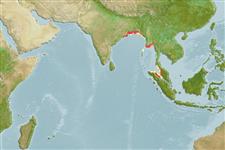Environment: milieu / climate zone / depth range / distribution range
Ecologia
marinhas; intervalo de profundidade 0 - 50 m (Ref. 189). Tropical; 25°N - 3°N, 85°E - 101°E (Ref. 189)
Eastern Indian Ocean: northeastern Bay of Bengal, from Calcutta south to the Indian Ocean coast of Thailand, perhaps to Pinang.
Tamanho / Peso / Idade
Maturity: Lm ? range ? - ? cm
Max length : 16.5 cm SL macho/indeterminado; (Ref. 189)
Descrição breve
Morfologia | Morfometria
Espinhos dorsais (total): 0; Espinhos anais 0; Raios anais moles: 41 - 45. Belly with 16 (rarely 17) + 11 to 13 = 27 to 29 keeled scutes from isthmus to anus. Tip of snout on level with upper rim of eye. Maxilla moderate, projecting a little beyond gill cover; first supra-maxilla minute, usually absent; teeth in jaws enlarged, especially in lower jaw. A dark blotch indistinct or absent behind upper part of gill opening; no dark lines along back.
Presumably schooling and inshore. More data needed.
Life cycle and mating behavior
Maturidade | Reprodução | Desova | Ovos | Fecundidade | Larvas
Wongratana, T., T.A. Munroe and M. Nizinski, 1999. Order Clupeiformes. Engraulidae. Anchovies. p. 1698-1753. In K.E. Carpenter and V.H. Niem (eds.) FAO species identification guide for fishery purposes. The living marine resources of the WCP. Vol. 3. Batoid fishes, chimaeras and bony fishes part 1 (Elopidae to Linophrynidae). FAO, Rome. (Ref. 9822)
Categoria na Lista Vermelha da IUCN (Ref. 130435)
Ameaça para o homem
Harmless
Utilização humana
Mais informação
Nomes comunsSinónimosMetabolismoPredadoresEcotoxicologiaReproduçãoMaturidadeDesovaAgregação para desovaFecundidadeOvosDesenvolvimento dos ovos
Idade/TamanhoCrescimentoComprimento-pesoComprimento-comprimentoFrequência de comprimentoMorfometriaMorfologiaLarvasDinâmica larvarRecrutamentoAbundânciaBRUVS
ReferênciasAquaculturaPerfil para aquaculturaEstirpesGenéticaElectrophoresesHereditariedadeDoençasProcessamentoNutrientsMass conversion
ColaboradoresFotografiasStamps, Coins Misc.SonsCiguateraVelocidadeTipo de nataçãoÁrea branquialOutras referênciasCérebrosVisão
Ferramentas
Relatórios especiais
Descarregue XML
Fontes da internet
Estimates based on models
Preferred temperature (Ref.
123201): 27.9 - 29.4, mean 28.7 °C (based on 68 cells).
Phylogenetic diversity index (Ref.
82804): PD
50 = 0.5000 [Uniqueness, from 0.5 = low to 2.0 = high].
Bayesian length-weight: a=0.00437 (0.00186 - 0.01024), b=3.11 (2.93 - 3.29), in cm total length, based on LWR estimates for this Genus-body shape (Ref.
93245).
Nível Trófico (Ref.
69278): 3.4 ±0.5 se; based on size and trophs of closest relatives
Resiliência (Ref.
120179): Elevada, tempo mínimo de duplicação da população menor que 15 meses (Preliminary K or Fecundity.).
Fishing Vulnerability (Ref.
59153): Low vulnerability (10 of 100).
